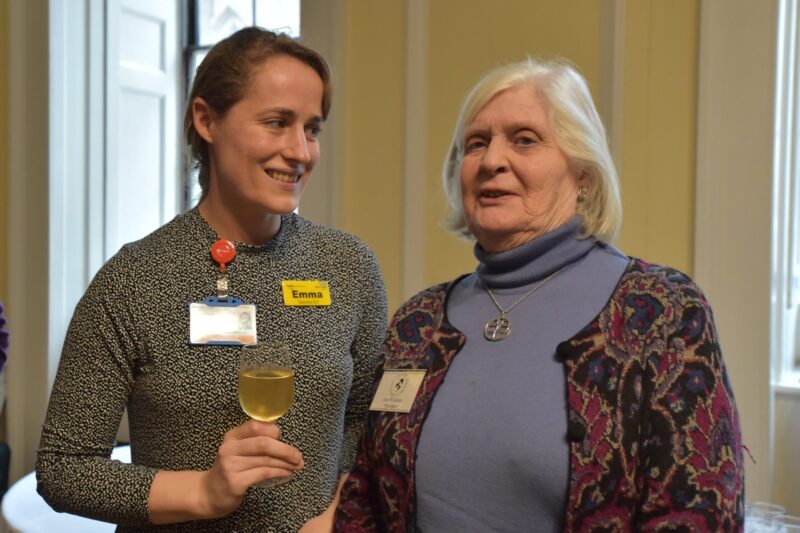Management of Dysphagia – Training Course

April 22nd, 2022
Guild grant recipient Emma Power, pictured with Guild President Ann Wickham, gives an insight into the world of a Speech and Language Therapist and how a specialist course enabled her to acquire additional skills to improve patient care.
Speech and language therapy is a relatively young profession, with its profession body only established in the UK in 1945. Brought to fame by Lionel Logue’s work with King George VI, speech and language therapy has grown and developed into many different areas and specialties over the years. Typically, one might think of a speech and language therapist (SLT) as a professional who works solely with stammers, language delays in children, or communication changes following stroke in adults. While there are SLTs dedicated to these domains, there is a wide variety of other areas that SLTs specialise in too.
SLTs might work with anyone ranging from a new-born to those in their final days, addressing any of the following: speech, understanding, reading, writing, voice, feeding and swallowing. It may be surprising to learn that there is a (growing) speech and language therapy team based at St Bartholomew’s Hospital; a tertiary centre that specialises in cardiothoracic surgery and oncology treatment. For example, we have a dedicated team of SLTs for those undergoing treatment of head and neck cancer, in which SLTs support with management of changes to voice and/or swallow as a consequence of radiotherapy (RT) side effects.
On the intensive care unit (ICU), SLTs often work with people who have artificial airways
(eg. a tracheostomy*): this can involve upper airway assessment, swallow rehabilitation, and communication assessment. A person is unable to access their voice when an artificial airway is in place; and it is the SLT’s role to assess and attempt to maximise other means of communication for a patient during this time,
eg. provision of a bespoke communication chart, or suitability to use a ‘speaking’ valve.
*A tracheostomy is an opening created at the front of the neck so a tube can be inserted into the windpipe (trachea) to help you breathe [NHS definition]
A large proportion of the patients that SLTs see in an acute setting have dysphagia (swallowing difficulties); this can arise from general weakness acquired during admission, be due to neurological complications such as stroke or a progressive disease, or be a complication of surgery. The presence of dysphagia can result in profound and far-reaching implications for a patient, the quality of their admission, and the quality of life after hospital. For example, if food or drink enters the lungs as a result of a swallowing difficulty, this might lead to a chest infection, medical complications and an extended admission. Therefore, early identification and management of dysphagia is paramount.
At St. Bartholomew’s Hospital, we are also fortunate to have access to two means of objective swallow assessment, which SLTs can complete to inform differential diagnosis and rehabilitation: Fibreoptic endoscopic evaluation of swallow (FEES: a tiny camera through the nose to look at a person’s throat while swallowing), and videofluoroscopy assessment of swallow (VFS: a video x-ray of someone eating and drinking).
In order to upskill my management of dysphagia, I completed a two-day training course about dysphagia assessment, the latest research around swallow rehabilitation and the use of VFS to objectively guide dysphagia management. I was very fortunate that Barts Guild saw the benefit of completing this course for improving patient care, and they provided me with a grant that afforded me a place on this course. It was hosted by the internationally renowned speech and language therapist, Dr Maggie Lee Huckabee, who has a long-ranging career in dysphagia research and treatment. Over the two days, attendees joined from all corners of the world to refresh knowledge about the neurophysiology of swallow, critically appraise the latest research relating to swallow diagnosis and rehabilitation, and to share case studies demonstrating current local practice.
As a result of my attendance on this course, I have had increased sensitivity to identifying those who require instrumental assessment, I have been able to re-enforce the theory I have learnt when completing VFS and have been more confident about prescribing targeted swallow rehabilitation programmes.
This has all contributed to improved safety and quality of life for our patients; for example, one patient reported that “it [establishing him eating and drinking] has transformed the quality of my admission”.
I am very grateful to Barts Guild for affording me this opportunity of continuous professional development. It is heartening to know that they continuously encourage staff to apply for support with funding for such a wide variety of developments to maintain an environment in which clinical excellence can flourish. They recently hosted an evening in which previous grant recipients were invited to share about what Barts Guild had supported them to accomplish. It was a privilege to mingle with such a great bunch of individuals and inspiring to hear about all the different work being done within the trust.
I hope readers have enjoyed a brief insight into the role of speech and language therapists at St. Bartholomew’s Hospital. We are always happy to hear from others, and would welcome anyone getting in touch to learn more about our team and the work we do.
EMMA POWER
Specialist Speech and Language Therapist
St Bartholomew’s Hospital
